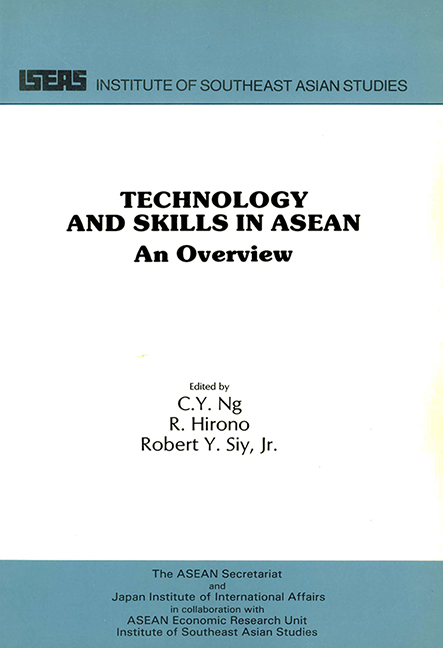Book contents
- Frontmatter
- Contents
- Foreword
- Preface
- PART ONE ASEAN OVERVIEW
- Introduction
- 1 Industrialization in ASEAN
- 2 Technology Transfer, Adaptation and Diffusion in Asean: Problems and Issues
- 3 Science and Technology Policies in Asean
- 4 The Experience From Selected Asean Industries
- 5 Conclusions and Recommendations
- PART TWO SECTION 1: JAPANESE OVERVIEW
- PART TWO SECTION 2: JAPANESE EXPERIENCES IN TECHNOLOGY TRANSFER
- The Editors
3 - Science and Technology Policies in Asean
from PART ONE - ASEAN OVERVIEW
Published online by Cambridge University Press: 09 November 2017
- Frontmatter
- Contents
- Foreword
- Preface
- PART ONE ASEAN OVERVIEW
- Introduction
- 1 Industrialization in ASEAN
- 2 Technology Transfer, Adaptation and Diffusion in Asean: Problems and Issues
- 3 Science and Technology Policies in Asean
- 4 The Experience From Selected Asean Industries
- 5 Conclusions and Recommendations
- PART TWO SECTION 1: JAPANESE OVERVIEW
- PART TWO SECTION 2: JAPANESE EXPERIENCES IN TECHNOLOGY TRANSFER
- The Editors
Summary
The transfer of technology has been a critical element in the industrialization plans of the ASEAN countries. Access to production technology has always been a necessary condition for the expansion of the manufacturing sector and ultimately the growth of industrial employment. Moreover, foreign firms have been regarded as the most ready and expedient source of industrial technology. Under these conditions, foreign direct investment was actively promoted in ASEAN as a means of gaining access to new technologies.
The import-substitution strategies of the 1950s encouraged transnational firms to establish production facilities within the trade barriers of the host countries. However, these policies promoted the dependence of domestic industries on foreign suppliers of technology and raw materials. Although foreign technologies were introduced, the import-substituting industries were insulated from competition from cheaper imports and, therefore, were under less pressure to increase production efficiency, reduce costs and utilize the more abundant factors of production. The availability of preferential credit for capital goods imports and the ready access to government allocation of foreign exchange tended to undervalue machinery and equipment and to encourage use of imported supplies and components. These policies emphasized the transfer of “hardware” instead of the “software” elements of technology. Moreover, the comfort of the protectionist measures and the limited domestic market reduced the inclination, respectively, to adapt the imported techniques to suit local conditions and to pursue economies of scale.
The shifts in the industrialization policies towards more export-oriented manufactures and the desire to reduce the dependence on foreign technology suppliers have caused the ASEAN nations to review their respective science and technology development policies and to institute measures to build local capacities to adapt, innovate, and absorb technology. The primary impetus for the enhancement of local technology and skills differ from country to country and so do their policies, measures, and institutions. The sections below discuss the activities and experiences of each of the ASEAN countries with regard to their efforts to promote science and technology development.
- Type
- Chapter
- Information
- Technology and Skills in ASEANAn Overview, pp. 25 - 32Publisher: ISEAS–Yusof Ishak InstitutePrint publication year: 1988

